 W
WCyclura rileyi nuchalis, commonly known as the Acklins ground iguana or Watling Island iguana, is an endangered subspecies of lizard of the genus Cyclura it is one of three subspecific forms of Cyclura rileyi in the family Iguanidae.
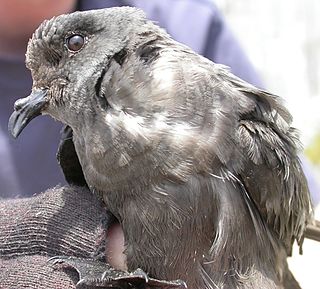 W
WThe ashy storm petrel is a small, scarce seabird of the storm petrel family Hydrobatidae. It breeds colonially on islands off the coasts of California and Mexico, and is one of six species of storm petrel that live and feed in the rich California Current system.
The black-crowned Central American squirrel monkey is a subspecies of the Central American squirrel monkey. Its range is restricted to the Pacific coast of western Panama to the western portion of the Chiriquí Province and of southern Costa Rica, south of the Rio Grande de Terraba, including the Osa Peninsula. It is the subspecies of Central American squirrel monkey seen in Corcovado National Park in Costa Rica. Its type locality is David, Panama, but its range apparently no longer extends that far east.
 W
WThe blue iguana, also known as the Grand Cayman ground iguana, Grand Cayman blue iguana or Cayman Island rock iguana, is an endangered species of lizard which is endemic to the island of Grand Cayman. It was previously considered to be a subspecies of the Cuban iguana, Cyclura nubila, but in a 2004 article Frederic J. Burton reclassified it as a separate species because according to him the genetic differences discovered four years earlier between the different C. nubila populations warranted this interpretation. The blue iguana is one of the longest-living species of lizard.
 W
WThe Ceiba stream frog is a species of frog in the family Hylidae endemic to Honduras. Its natural habitats are subtropical or tropical moist lowland forests, subtropical or tropical moist montane forests, and rivers. It is threatened by habitat loss.
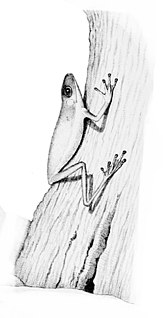 W
WThe Costa Rica brook frog or red-eyed stream frog is a species of frog in the family Hylidae found in Costa Rica and Panama. Its natural habitats are tropical moist lowland forests, subtropical or tropical moist montane forests, and rivers.
 W
WThe northern Bahamian rock iguana is a species of lizard of the genus Cyclura that is found on Andros Island and the Exuma islands in the Bahamas. Its status on the IUCN Red List is vulnerable, with a wild population of less than 5,000 animals.
 W
WThe Allen Cays rock iguana or Allen Cays iguana is a subspecies of the northern Bahamian rock iguana that is found on Allen's Cay and adjacent islands in the Bahamas. Its status in the IUCN Red List is critically endangered, with an estimated wild population of 482–632 animals.
 W
WCyclura ricordii, also known in English as Ricord's ground iguana, Ricord's iguana or Ricord's rock iguana, is an endangered species of medium-sized rock iguana, a large herbivorous lizard. It is found on the island of Hispaniola, in both Haiti and the Dominican Republic. It is known to coexist with the nominate subspecies of C. cornuta, these two being the only taxa of rock iguana to do so. The natural habitats of its three subpopulations are hot, dry, wooded savanna on limestone with access to soil, and sandy flats, in southern Hispaniola. It is threatened by predation by introduced predators and habitat loss, due to overgrazing and charcoal manufacture.
 W
WEleutherodactylus ruthae is a species of frog in the family Eleutherodactylidae. It is endemic to Hispaniola and known from scattered locations in both Haiti and the Dominican Republic. It was described by Gladwyn Kingsley Noble, who named it in honour of his wife, Ruth Crosby Noble; she also first discovered the species. It might represent more than one species. Eleutherodactylus aporostegus, Eleutherodactylus bothroboans, Eleutherodactylus tychaethrous were first described as subspecies of Eleutherodactylus ruthae, but have later been elevated to full species status.
 W
WExerodonta catracha is a species of frog in the family Hylidae. It is endemic to Honduras. Its natural habitats are subtropical or tropical moist montane forests, rivers, and freshwater marshes. It is threatened by habitat loss.
 W
WGeoffroy’s spider monkey, also known as the black-handed spider monkey or the Central American spider monkey is a species of spider monkey, a type of New World monkey, from Central America, parts of Mexico and possibly a small portion of Colombia. There are at least five subspecies. Some primatologists classify the black-headed spider monkey, found in Panama, Colombia, and Ecuador as the same species as Geoffroy's spider monkey.
 W
WThe grey-crowned Central American squirrel monkey is a subspecies of the Central American squirrel monkey. Its range is restricted to the Pacific coast of central Costa Rica. The northern end of its range is the Rio Tulin and the southern end of its range is the Rio Grande de Terraba. South of the Rio Grande de Terraba, it is replaced by the black-crowned Central American squirrel monkey, S. oerstedii oerstedii. Populations are very fragmented, and the subspecies does not occur in all locations within its general range. It is the subspecies of Central American squirrel monkey seen in Manuel Antonio National Park in Costa Rica.
 W
WThe Guatemalan black howler, or Yucatan black howler, is a species of howler monkey, a type of New World monkey, from Central America. It is found in Belize, Guatemala and Mexico, in and near the Yucatan Peninsula. It lives in evergreen, semideciduous and lowland rain forests. It is also known as the baboon in Belize, although it is not closely related to the baboons in Africa.
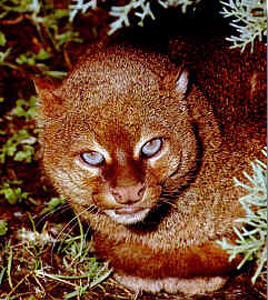 W
WThe Gulf Coast jaguarundi is a population of the jaguarundi. Two of these populations—the Gulf Coast jaguarundi and the Sinaloan jaguarundi—are considered endangered and were put on the endangered list on June 14, 1976. These cats are placed under the family Felidae and the subfamily Felinae because of their small size. As of 2017, the Cat Classification Taskforce of the Cat Specialist Group does not recognise any subspecies of jaguarundi.
 W
WThe horned marsupial frog, originally named Nototrema cornutum Boulenger after the first describer George Albert Boulenger in 1898), is a species of frog in the family Hemiphractidae. It is an arboreal species found in Colombia, Costa Rica, Ecuador and Panama. Its natural habitats are tropical moist lowland forests and montane cloud forests. It is threatened by habitat loss.
 W
WIncilius tutelarius is a species of toad in the family Bufonidae. It is found in the Sierra Chimalapa and Sierra Madre de Chiapas in Guatemala and Chiapas, Mexico. Its natural habitats are cloud forests and pine-oak (broadleaf) forests. It is closely associated with streams, its breeding habitat. It is threatened by habitat loss.
 W
WThe Jamaican snoring frog, or Harlan's Antilles frog, is a species of frog in the family Hylidae endemic to central Jamaica. Its natural habitats are mesic broadleaf woods and forests with large dead trees. It can be found on tree trunks and in bromeliads; males call from hollows in branches and bromeliads. Eggs are laid in bromeliads. It is threatened by habitat loss.
 W
WThe Lesser Antillean iguana is a large arboreal lizard endemic to the Lesser Antilles. It is one of three species of lizard of the genus Iguana and is in severe decline due to habitat destruction, introduced feral predators, hunting, and hybridization with its introduced sister species, the green iguana. Successful captive breeding of this species has been limited to only two instances, as most captive-laid eggs tend to be infertile.
 W
WThe loggerhead sea turtle, is protected under the Endangered Species Act (ESA) of 1973. It was originally listed as a threatened species on July 28, 1978. The loggerhead turtle is the most prolific species of sea turtle in U.S. coastal waters.
 W
WThe Mexican wolf, also known as the lobo, is a subspecies of gray wolf once native to southeastern Arizona, southern New Mexico, western Texas and northern Mexico. It is the smallest of North America's gray wolves, and is similar to C. l. nubilus, though it is distinguished by its smaller, narrower skull and its darker pelt, which is yellowish-gray and heavily clouded with black over the back and tail. Its ancestors were likely the first gray wolves to enter North America after the extinction of the Beringian wolf, as indicated by its southern range and basal physical and genetic characteristics.
 W
WThe sheepshead minnow or sheepshead pupfish is a species of ray-finned fish in the family Cyprinodontidae, the pupfishes. It is found in salt marsh and estuary environments and is native to the eastern coasts of North and Central America.
 W
WThe Mona ground iguana is a rock iguana that is a subspecies of the rhinoceros iguana. It is endemic to Mona Island, Puerto Rico and is the largest native terrestrial lizard in Puerto Rico.
 W
WOedipina gephyra, commonly known as the La Fortuna worm salamander, is a species of salamander in the family Plethodontidae. It is endemic to Honduras.
 W
WThe sea otter is a marine mammal native to the coasts of the northern and eastern North Pacific Ocean. Adult sea otters typically weigh between 14 and 45 kg, making them the heaviest members of the weasel family, but among the smallest marine mammals. Unlike most marine mammals, the sea otter's primary form of insulation is an exceptionally thick coat of fur, the densest in the animal kingdom. Although it can walk on land, the sea otter is capable of living exclusively in the ocean.
 W
WThe peninsular myotis is a species of vesper bat. It is endemic to northwestern Mexico, found only within Baja California Sur state on the southern Baja California Peninsula. Its habitats include the southern Peninsular Ranges and deserts.
 W
WPtychohyla salvadorensis is a species of frog in the family Hylidae found in El Salvador, Guatemala, and Honduras. Its natural habitats are subtropical or tropical moist montane forests, rivers, pastureland, and heavily degraded former forests. It is threatened by habitat loss.
 W
WThe Quino checkerspot is a butterfly native to southern California and northwestern Baja California. It is a subspecies of the common Edith's checkerspot and the second such subspecies to be listed under the federal Endangered Species Act.
 W
WThe relict splitfin is a species of splitfin endemic to the Pánuco River system in Mexico. It feeds on algae. This species grows to 6 centimetres (2.4 in) in length. It is found in the aquarium trade. It is the only known member of its genus.
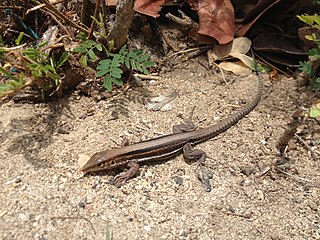 W
WThe Saint Croix ground lizard is a member of the Teiidae family of lizards.
 W
WNototriton limnospectator is a species of salamander in the family Plethodontidae. It is also called the Santa Barbara moss salamander. It is endemic to Honduras.
 W
WThe Tehuantepec jackrabbit is easily distinguished from other species of jackrabbits by two black stripes that run from the base of the ears to the nape, and by its white flanks. Underparts are white, upperparts are bright-brown washed with black, rump is gray, and the tail is black. This leporid is one of the largest jackrabbits and has large ears and legs. Adults weigh about 3500 to 4000 grams.
 W
WThe California least tern, Sternula antillarum browni, is a subspecies of least tern that breeds primarily in bays of the Pacific Ocean within a very limited range of Southern California, in San Francisco Bay and in northern regions of Mexico. This migratory bird is a U.S. federally listed endangered subspecies. The total population of the subspecies amounted to 582 breeding pairs in 1974, when census work on this bird began. While numbers have gradually increased with its protected status, the species is still vulnerable to population decline through natural disasters, predation, and human disturbance.
 W
WThe Tres Marias raccoon is a subspecies of the common raccoon endemic on the two main islands of the Islas Marías, an archipelago off the western coast of the Mexican state of Nayarit. Although sometimes considered to be a valid species, the Tres Marias raccoon is now regarded to be a subspecies of the common raccoon, introduced to the Islas Marías in the recent past. It is slightly larger than the common raccoon and has a distinctive angular skull. There are fewer than 250 mature individuals on the islands, they are hunted by the islanders and the International Union for Conservation of Nature has rated their conservation status as being "endangered".
 W
WThe wood turtle is a species of turtle endemic to North America. It is in the genus Glyptemys, a genus which contains only one other species of turtle: the bog turtle. The wood turtle reaches a straight carapace length of 14 to 20 centimeters, its defining characteristic being the pyramidal shape of the scutes on its upper shell. Morphologically, it is similar to the bog turtle, spotted turtle, and Blanding's turtle. The wood turtle exists in a broad geographic range extending from Nova Scotia in the north to Minnesota in the west and Virginia in the south. In the past, it was forced south by encroaching glaciers: skeletal remains have been found as far south as Georgia.
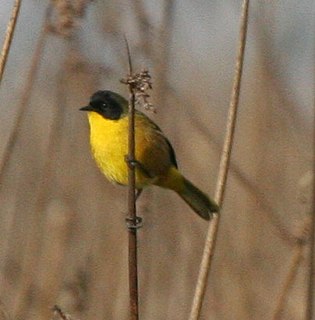 W
WThe black-polled yellowthroat is a species of bird in the family Parulidae.
 W
WThe Yucatan spider monkey is a subspecies of Geoffroy's spider monkey, and is one of the largest types of New World monkey. It inhabits Mexico, Guatemala and Belize. It is a social animal, living in groups of 20-42 members.
 W
WZoogoneticus tequila, Tequila splitfin or simply Tequila fish, is a species of goodeid fish from Mexico. The specific epithet, tequila, derives from the Tequila Volcano, which looms near the type locality.